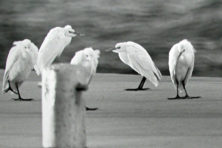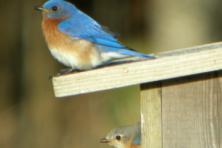Door County Antennas Tune in to Migrating Birds
- Share
- Tweet
- Pin
- Share

Door County birders might see a short-billed dowitcher wading in the shallows during summer or early fall, but until now, they couldn’t tell where that bird came from or where it was going.
Now that the Lake Michigan Bird Observatory has installed 20 radio-telemetry stations along the western side of Lake Michigan, biologists and the public can learn just how briefly some migratory birds visit Door County, and how rapidly they can go to the South from their nesting grounds.
Two weeks after a station installation on Washington Island, that antenna detected a radio signal from a band on a dowitcher. Biologists didn’t find the detection remarkable, but they were amazed by the speed of its migration.
“It was a short-billed dowitcher that was tagged in northeastern Manitoba and then [after the Washington Island detection], the next day it was detected in Georgia. It really was moving,” said Jacob Woulf, Lake Michigan Bird Observatory coordinator of The Motus Wildlife Tracking System (Motus).

Photo by US Fish and Wildlife Service.
Motus is an international collaborative research network that uses coordinated, automated radio telemetry to facilitate research and education on the ecology and conservation of migratory animals, according to its website, motus.org.
“Motus works by having radio transmitters on birds and when they go near the towers, the radio signal is intercepted by that receiver,” said Jennifer Phillips-Vanderberg, the Lake Michigan Bird Observatory’s executive director. “It allows scientists to understand migration across the hemisphere on a different level than we have been able to in the past.”
Birders provide data on where birds are seen, “but we don’t know where those individuals are actually coming from,” Phillips-Vanderberg said. They’ve learned through Motus that birds traveling past Lake Michigan have traveled from nesting grounds in northern Canada, such as James Bay and Hudson Bay.
“It’s kind of amazing to see how fast they go through – like in a matter of two days, they go from pretty far north in Canada to here and to the Gulf and southern states,” Phillips-Vanderberg said.
The Lake Michigan Bird Observatory (the Observatory), based in Port Washington, installed three Motus antennas in Door County between Oct. 5 and 12. The grant-funded installations will help biologists study migration times, speed, pathways and stopovers. One of the installations is on a tower at Camp Wabansi near Brussels; the second is near the Door County Astronomical Society headquarters north of Crossroads at Big Creek; and the third is at The Ridges Sanctuary in Baileys Harbor on a pole used for an osprey-nesting platform.
“We’re hosting a tower to help build up the network,” said Sam Hoffman, Ridges Sanctuary land manager.
The antennas can detect birds – or other animals such as long-eared bats – as far as three to six miles away, Hoffman said. The tower at the Ridges might detect birds anywhere in Baileys Harbor, out toward Toft Point, inland toward Kangaroo Lake or simply flying a couple of miles out over Lake Michigan.
This summer, the Observatory added antennas on the Algoma High School roof and a solar-powered station on the Door County Land Trust’s Domer-Neff Nature Preserve and Bird Sanctuary near the famous Stavkirke on Washington Island.

Antennas throughout the United States and in Central America upload data to the internet, Woulf said. This allows scientists to track the migration routes. The Wisconsin portion of the Motus project – a Latin word for “movement” – made a detection this year that helped scientists learn a lot more about Swainson’s thrushes, a particular thrush that appears to be in decline in some of its breeding grounds near the Pacific Ocean. An antenna on a school in Kenosha picked up the signal of a Swainson’s thrush that had been tagged in August of 2022 in Vancouver, British Columbia, which revealed an unusual migration route.
“It made this big movement east toward Wisconsin and cut down through Florida and over into Central America,” Woulf said. “It’s really cool to see that track, and even cooler to have multiple years of data.”
The Observatory received a Sustain Our Great Lakes grant to add 14 towers, so far, at about $3,000-$5,000 apiece, along the western shore of Lake Michigan, including within Green Bay; at Oneida near the Fox River; and at Kaukauna near Lake Winnebago. The group had 20 towers in total online as of Oct. 13, with more to come.
Other organizations install towers on the east side of the lake and throughout the Americas.
Phillips-Vanderberg said anyone can visit motus.org to see the map of the hemisphere and times and locations of tag detections.
“It’s public information,” she said. “You don’t have to be a scientist to appreciate how cool it is to see where these birds are going.”
The mapping also can help guide habitat conservation, Phillips-Vanderberg said.
“If we’re looking at a certain species, we want to see how long it’s in a certain area and to see how that particular area is important to a specific species or multiple species,” Phillips-Vanderberg said. “Are they coming there for specific habitat, or a food source?”


